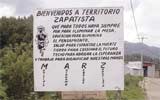JBG governs indigenous EZLN-run communities

Bread to illuminate the table; Education to feed the thought; Health to scare away death; Land to cultivate the future; Roof to protect hope; And work to dignify our hands."The sign stands outside Ovantic.
This sign reads, “Welcome to Zapatista territory. That for everyone there (will) always be
President Ernesto Zedillo created a legislative committee, which was later to be named COCOPA, with the aim to reach a peaceful and honorable agreement between the federal government and the EZLN. An agreement, called Los Acuerdos de San Andres, was reached between the COCOPA and the EZLN in 1996.
Although the agreement was seen as a great achievement and the basis for a final accord between the government and the EZLN, Zedillo saw in the initiative (for a bill) a serious threat to national unity. He believed the provisions would allow the indigenous communities to be autonomous and to have the power of self-determination, which incorporated the right to decide the form of government and social organization within their communities, could potentially lead to national division like the Basque state in Spain or the split of the Soviet Union and Yugoslavia.
The Zedillo’s government returned an alternative agreement to the EZLN that was close to Los Acuerdos de San Andres excluding those provisions that would give the indigenous communities autonomy and self-determination. The EZLN rejected the offer,. According because it was seen as an attempt by the government to integrate the indigenous people into occidental civilization.
The EZLN believed autonomy and self-determination would create the necessary rules that would allow the indigenous communities to fully participate in Mexican society. The federal government, however, thought such provisions would set the dangerous precedent indigenous communities can create their own mini-states – that could marginalize these people even more from progress.
Los Acuerdos de San Andres wouldn’t reach congress until President Vicente Fox came into power in 2000. But again the bill was rejected by congress for the same reasons — the provisions of autonomy and self-determination are a danger to national unity. This time not only is the former party in power, the PRI, against the bill but the president’s party, the PAN, as well.
Even though the EZLN was defeated in the legislative battlefield it went ahead and constructed unconstitutional, autonomous communities, called Los Caracoles, whose governing body would be Las Juntas de Buen Gobierno. These autonomous communities would follow the political structures and social customs that would have been allowed if Los Acuerdos de San Andres had become law.
In the press releases of 2004, Sub-Comandante Marcos informs of the state of these communities. The state of the JBGs cites several examples of fruitful communication between the JBGs and the state and local governments of Chiapas in order to show that two governing bodies can co-exist, even if their political, social and judicial mechanisms are fundamentally different. He shows of an example in where the state government and the JBG cooperated in a rape case. The positive co-existence of two politically distinct groups is used by Marcos to show the creation of autonomous communities would not endanger the unity of the Mexican state.
In effect, the state of the JBG has been a deliberate political move by the EZLN. In the address, Marcos attacks the criticism made against Los Acuerdos de San Andres; among them the creation of mini-states that would lead to a disintegration of the Mexican state, and the violation of individual rights in favor of the exercise of collective rights.
Although the EZLN’s response to the criticism that the autonomous indigenous communities will lead to the creation of mini-states that will damage national unity might be convincing, the criticism that the autonomous indigenous communities will tolerate the violation of individual rights in favor of the exercise of collective rights is still powerful.
The state of the JBGs refers to examples of individual rights protected in these communities such as the right to choose to terminate a pregnancy, the right to practice the religion of one’s choosing, among others, as examples that the autonomous indigenous communities protect individual rights as much as, if not more than, the Mexican state. That said, the JBGs control of the use of natural resources in these communities in favor of collective rights abridges the individual rights of those whose desire, and/or need, more ample use of these resources to better their welfare.
On the other side, the EZLN could use the example of women’s right to show a case where rights are more protected in the JBG than in Mexico. Several investigators have found more progress has been made within the JBG toward equal rights between men and women than in other indigenous communities.
Whether one agrees with the government’s reservations on Los Acuerdos de San Andres or not, the JBGs have been a sneak peek on what could happen if Los Acuerdos de San Andres were to become law. For that reason, they are worth studying.
Your donation will support the student journalists of Missouri Southern State University. Your contribution will allow us to purchase equipment and cover our annual website hosting costs.



























